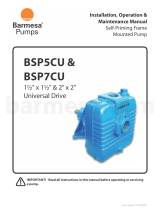
4
Installation
4Installation
These pumps are recommended for
use in a sump or basin. The sump,
basin or lift station shall be sealed
and vented in accordance with local
plumbing codes. This pump is
designed to pump sewage,
effluent or wastewater, non-
explosive and non-corrosive
liquids and shall NOT be installed
in locations classified as hazardous
in accordance with the National
Electrical Code (NEC) ANSI/NFPA
70 or Canadian Electric Code (CEC).
The minimum sump depth should be
at least 24". Check the dimensions for
minimum sump diameter. These are
minumum requirements.
The pump should never be installed
in a trench, ditch, or hole with a dirt
bottom. The legs will sink into the dirt
and the suction will become
plugged.
A. Excavation: Excavate the hole as
small as possible, with minimum
recommended 8" diametrical
clearance around the tank. Never
place basin directly in contact with
rocks or other sharp objects. Place
only fine, 1/8" to 3/4" pea gravel or
1/8" to 1/2" washed, crushed stone as
bedding between the basin and the
hole walls. Do not use sand or native
soil as backfill. Properly compact
underneath the basin to provide a
solid level base that can support the
weight of the filled basin.
B. Inlet Connection & Initial
Backfill: Only fine, 1/8" to 3/4" pea
gravel or 1/8" to 1/2" washed,
crushed stone should be used
around the bottom of the basin to
hold it in place. Do not use sand or
native soil as backfill. Make the inlet
connection as required for your
basin.
C. Final Backfill: Only fine 1/4" to
3/4" pea gravel or 1/8" to 1/2"
washed crushed stone is
recommended. Do not use sand or
native soil as backfill.
4Discharge Piping
Discharge piping should be as short
as possible and sized no smaller than
the pump discharge. Do not reduce
the discharge pipe size below that
which is provided on the pump.
Both a check valve and a shut-off
valve are recommended for each
pump. The check valve is used to
prevent backflow into the sump. The
shut-off valve is used to manually
stop system low during pump
servicing.
4Electrical Connections
Power cable:
The power cable mounted to the
pump must not be modified in any
way except for shortening to a
specific application. This pump is
provided with a 3 wire cord and 3
prong grounded plug that must be
connected into a 3 wire grounded
Ground Fault receptacle. DO NOT
USE THE POWER CABLE TO LIFT
PUMP. Do not use an extension cord.
Overload Protection:
Single Phase - The stator in-winding
overload protector used is referred to
as an inherent overheating protector
and operates on the combined effect
of temperature and current. This
means that the overload protector
will trip out and shut the pump off if
the windings become too hot, or the
load current passing through them
becomes too high.
Always rely upon a Certified
Electrician for installation.
IMPORTANT! - The overload will then
automatically reset and start the
pump up after the motor cools to a
safe temperature. In the event of an
overload, the source of this condition
should be determined and corrected
immediately.
2.Check Pump Rotation - Improper
motor rotation can result in poor
pump performance and can
damage the motor and/or pump.
Incorrect rotation for Single-Phase
pumps is unlikely. If the rotation is
incorrect contact factory.
4Pre-Operation
1.Check Voltage and Phase -
Compare the voltage and phase
information stamped on the
pump name plate.
3.Name Plate - Record the
information from the pump name
plate to drawing in front of
manual for future reference.
4.Insulation Test - An insulation
(megger) test should be
performed on the motor. Before
the pump is put into service. The
resistance values (ohms) as well
as the voltage (volts) and current
(amps) should be recorded.
5.Pump-Down Test - Be sure pump
has been properly wired, lowered
into the basin, sump or lift station,
check the system by filling with
liquid and allowing the pump to
operate through its pumping
cycle. The time needed to empty
the system, or pump-down time
along with the volume of water,
should be recorded.
barmesa.com











